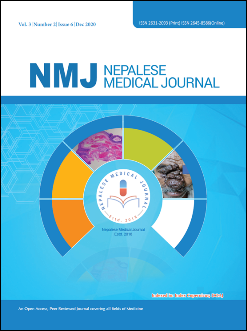An An Analysis of Causes and Avoidable Factors of Perinatal Deaths at Tertiary Care Hospital
DOI:
https://doi.org/10.3126/nmj.v4i1.36994Keywords:
Congenital anomaly; Intrapartum hypoxia;Perinatal deaths; Preterm deliveryAbstract
Introduction: Perinatal deaths are potentially preventable and reflect the quality of care provided in the prenatal period, during labor, and to a newborn. The purpose of this study was to assess the causes and avoidable factors contributing to perinatal deaths in the year 2018-19 and compare these with the previous two years at Tertiary Care Hospital.
Materials and Methods: This study was conducted from a retrospective analysis of all stillbirths and early neonatal deaths in the year July 2018 to July 2019. The Perinatal Mortality Rate, causes, and avoidable factors leading to perinatal deaths were analysed during this year and were compared with that of the previous two years at KIST Medical College and Teaching hospital.
Results: PMR was 16.09 per 1000 births in the year 2018-19. Previous two studies at this hospital in the year 2017-18 and 2016-17 showed a Perinatal Mortality Rate of 14.61 and 16.27/1000 births respectively. The commonest primary cause of perinatal deaths was intrapartum hypoxia 6 (30%), preterm delivery 5 (31.25%), and congenital anomalies
4 (19%) during the year 2018-19, 2017-18, and 2016-17 respectively. The most common avoidable factors identified were a maternal delay to seek health care, inadequate antenatal checkups, and inadequate antenatal counseling of danger signs by a service provider over the last three years.
Conclusions: Maternal delay to seek health care and lack of maternal knowledge of danger signs during pregnancy were the common avoidable factors identified. More efforts should be made to raise awareness of pregnant women during antenatal care visits regarding early healthcare-seeking behavior when needed.
Downloads
Downloads
Published
How to Cite
Issue
Section
License
Copyright (c) 2021 Sunita Bhandari, Yam Dwa, Riya Sharma

This work is licensed under a Creative Commons Attribution 4.0 International License.
This license enables reusers to distribute, remix, adapt, and build upon the material in any medium or format, so long as attribution is given to the creator. The license allows for commercial use.
Copyright on any article published by Nepalese Medical Journal is retained by the author(s).
Authors grant Nepalese Medical Journal a license to publish the article and identify itself as the original publisher.
Authors also grant any third party the right to use the article freely as long as its integrity is maintained and its original authors, citation details and publisher are identified.




